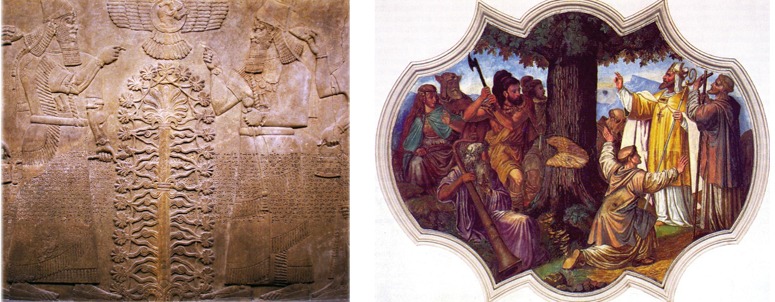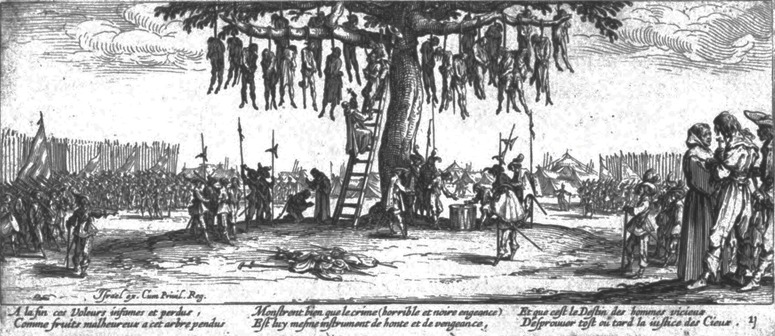The illustrations show a Tree of Life (above left) in ancient West Asia, the felling of a Sacred Tree by St Boniface (Thor’s Oak, above right) and a Hanging Tree during the 30 Years War (below).
What do the illustrations tell us about changing attitudes to trees in western civilization? Here are some possibilities:
- the ancients saw trees (and forests) as symbols of the natural forces which control the world
- the early Church regarded tree-worship as idolatrous, because there is only one true God
- both trees and people were destroyed in the religious wars of the seventeenth century
In clearing and ‘managing’ what is left of the world’s forest cover we may be marching in the path of the Easter Islanders. At present, the most densely wooded countries are Finland (86% of the total land area), Sweden (57%) and Austria (47% ). Australia, suprisingly, has 20.1% forest cover. The European countries with the least forest are Ireland, with 8% of the land as forested and the United Kingdom with 11%.



Australia has worked hard for decades now to reduce that pesky forest cover. Give us time and we’ll get rid of it.
Perhaps it is a good thing that trees can’t talk. No doubt they would be traumatised by all the violence that has surrounded them and even been perpetrated in the their very branches.
I suppose the most fortuneate trees are those that have been grown in the most peaceful surroundings (…maybe the only recently discovered Wollemi pine in Australia is in this category?)
“Ha, Ha, Ha” is most probably what the Easter Island trees would say if they could talk (see comments on Sacred Lotus)
Sakyamuni (‘the Lion of the Sakyas’=Buddha) preached under trees, lived under trees and died under trees. So Buddhism has always respected trees.
It seems a lot of Canadians artists are pondering our relationship with trees/the forest:
Don Maynard – Franken Forest at Agnes Etherington Gallery, Kingston, Ontario
Robert Hengeveld – Floating forgery at Katherine Mulherin Gallery, Toronto,
Dan Nuttall – Bewilderness – at FIELDWORK, near Kingston, Ontario
Nuttall’s work is currently (2010) showing at a rural open air art installation site located about an hour north of Kingston, Ontario in Canada.
There are two ways to access his work:
1. To get an idea of his process and thoughts during installation you can catch his blogging on the fieldwork web site: http://www.fieldworkproject.com
2. To see the entire completed installation you can visit his web site http://www.dandoesdesign.com. Go to “Recent Work” and you can see this installation as well as some recent landscape architecture work in Brooklyn and Toronto. To go directly to content about the installation press here: BEWILDERNESS.
Take care,
Isnt it shameful that the Uk has taken upon itself to berate the harvesting of acreages of tropical hardwood by the owners of such assets and go further in insisting that these assets be ‘managed’ and yet the many tonnages of Oak we stripped from our own landscape hundreds of years ago to go to making our navies are still waiting to be replaced. Why not heavily replant places such as The New Forest with mixed hardwoods and make some contribution to increasing our wooded areas with timber of worth? Why not encourage the replanting of acreages of hill or mountainside in Wales and Scotland, Yorkshire, the Peak District with lots more mixed woodland..It will go towards storing more water in the rocks below thus slowing down the flash flood issues we seem to be encoutering more often. It would benefit the environment in so many ways.
It is true: the UK has carried out the forest clearance which we are now criticising other countries in Africa, South America and SE Asia for doing. And yes, we could do much to foster the growth of hardwood woodlands. Perhaps it is necessary for those countries we criticise to start criticising us.
I guess we all have to acknowledge where we are at this particular time in history with our own unique philosophical perspectives and histories to go forward in the best way possible.
It is fantastic that there is so much natural heritage left in the world, and that we now have a sense of its great worth and can work together for its preservation.
Equally there is a rich cultural heritage in countries that have often depleted their natural heritage…and the manmade heritage is worth preserving also.
Here is the particular benefit of the concept of sustainable development. We can work together towards preserving both the rich natural and cultural legacies and share with each other the benefits.
It sometimes appears that ‘environmentalists’ are professional pessimists and ‘developers’ are professional optimists – so a sense of environmental optimism is most welcome.
Interestingly most “uncivilized” cultures have had natural respect for their environment, and have got along very well for thousands of years…
Like native Californian Americans have treated their forests with great respect and kept it like a garden, even though they had a form of personal ownership of land and even trees.
It was the “civilized” Europeans that came and cut down all ancient living solely for making as much quick money as possible not regarding any other not even their own interests; and we are now watching us burning down the rest…
So I guess disrespect of ones basics is characteristic of malfunctioning societies… which also is a sad statement for our moral representatives like the ones that cut down Thor’s oak…
So – referring to Toms remark – lets back the moral authority of all environmental optimists…
To create a new mindset about trees and the environment is not easy for us here in the US because we see landscape as disposable. Outside bars here in the Boston area purchase palm trees from Florida for the summer to make the landscape space ‘more tropical’. In the Fall the bar owners pull the trees up and chuck them into a large dumpster.
‘Civil’ and ‘civilized’ derive from the Latin civilis “relating to a citizen, relating to public life, befitting a citizen,”. The word therefore has everything to do with cities and little to do with the countryside or wild nature – or to those who live in such places. I think this tells us why ‘civilization’ has led to the destruction of rivers, trees, meadows and other aspects of wild nature.
It would be interesting to study cultures which have a closer relationship between built form and wild nature….
Also there may be a question of boundaries here. For example in Alaska the notion of meeting a brown bear in the outdoors is still a reality (even if a remote one).
[ http://www.mgfalaska.com/brownbear.html ]
In Britain it is said the brown bear became extinct around 500AD due to hunting. However, before this time humans and brown bears obviously co-existed.
[ http://en.wikipedia.org/wiki/Eurasian_Brown_Bear ]
Chauvet would be one of the best places to think about relationships between man and bears – if one could gain entry. Partly because of the access problem, I think it may the most wonderous place in Europe.
Yes, exactly. There are some very gory stories from the spectacles of the Roman amphitheatre in which the Caledonean bear and cross (on which a criminal is executed) are both present.
So I can suppose that many of the bears of Britain found their way to Rome during the time of Roman Britain.
I suppose the Roman love of gory spectacles was a carry-over from the hunter-gatherer era in which the hunting was (1) the main way of obtaining protein, especially in winter(2) the main sport (3) the field of endeavour which most attracted females to males. So spectacles in amphitheatres could be regarded as a way of bringing culture to the masses – the mp3 music of their day. Catalonia realised, earlier this year, that it was time for this type of cultural event to be ended. They have banned bull fighting.
Bull fighting it seems was introduced into Spain during a period of wars between the Moors and Christians:
“The event of bullfighting originated in Spain during the Spanish War of Reconquest from 711 to 1492 A.D. In this war between the Moors and Christians, each side created hunting competitions to rest from battling one another. Basically, the Moors and Christians would go from killing each other to competing with each other. Each side eventually learned that of all the prey they went after, the Iberian bull was the greatest challenge. The bull revealed that it would rather die fighting than run away.”
[ http://www.ehow.com/about_5127110_history-bull-fighting.html ]
I suppose this means there is some connection between actually ‘fighting’ and watching ‘fighting’?
I wonder if it was a specific type of bull-fighting which arose in the Middle Ages. The Wiki history of bull-fighting seems to agree with my assumption that it has a Roman and pre-Roman origin.
It seems in earlier times the evolution of the bullfight represented the victory of the Moors over the Christians. [ http://www.spanish-fiestas.com/bullfighting/history.htm ]
The origin of the bull symbolism in Spain however seems to go back to the 7th of the 12 labours of Hercules. The 7th labour Hercules was asked to perform was to catch the fire breathing bull of Crete. Carlos Feuntes in ‘The buried mirror: reflections on Spain and the New World’ says(p19):
“Hercules bought the mythology of the bull to Spain. Like Thesus, Hercules killed a fire-breathing bull in Crete. But he also travelled to Spain, there to steal the herd of red bulls belonging to the three-bodied giant, Geryon, and drive them back to Greece. Hercules had to cross the narrow strait between Africa and southern Spain to do this; therefore the name of that passage the Pillars of Hercules. Yet the strait is more than a geographic recognition. It symbolises both the bond and the separation inherent in one of humankind’s oldest ceremonies: a ritual slaying of the sacred animal. Hercules proved his nobility by returning some of the cattle to Spain, in recognition of the hospitality he received there. The ruling king Chrysoar, then established the ritual of sacrificing a bull to Hercules every year.”
The connection with Cretan bulls is iteresting. Bulls had a religious significance in many ancient cultures (eg Catal Huyuk) so I suppose they became a symbol of paganism/idolatry – and therefore a natural enemy.
Yes, perhaps the historic red bulls of Spain have some relationship with Catal Huyuk. [ http://commons.wikimedia.org/wiki/File:Catal_H%C3%BCy%C3%BCk,_bull_painting.JPG ]
It is interesting that the unofficial symbol of Spain today is the (black) bull. [ http://www.andalucia.com/culture/osborne-bull.htm ] Yet the Basques in protest have put forward the image of the Basque sheep?
The ancient Greeks knew the Basques as the goat people – and the goat seems a better choice than the sheep for a conflict with bulls. I sympathise with the Basque desire for independence – but wish they would use Ghandian methods. They could get a lot of international media attention with mass rallies of goats.
You are right peaceful means of protest are always and everywhere preferred.